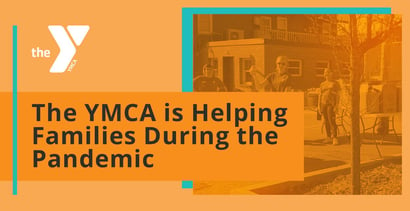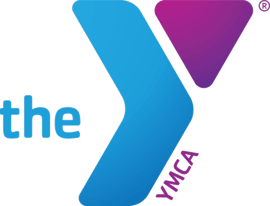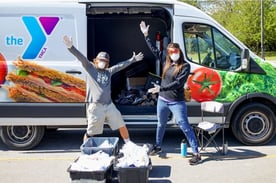

In a Nutshell: When schools closed abruptly during the spring, many underserved children across the U.S. were left without their only dependable source of nutrition via school breakfast and lunch. Meanwhile, parents were left without child care. The challenges are continuing into the fall as schools open with virtual options and some have even had to send many students home to quarantine. The YMCA has stepped up to support its communities by helping feed children suffering from food insecurity. The long-running nonprofit has more than 1,000 child care facilities across the country for the children of healthcare professionals and essential workers. The Y also hosts a robust selection of virtual programming to help children and families stay healthy — both mentally and physically — and avoid debt, during these challenging times.
In early 2020, as the COVID-19 pandemic swept across the nation, schools, restaurants, and other institutions quickly closed their doors to help prevent the spread of the deadly virus.
While these initial closures were necessary — the safety of U.S. residents is paramount — the shutting down of schools and many important community programs left millions of children vulnerable to food insecurity.
Meanwhile, many parents who still had to work were left without access to child care.
 Thankfully, the YMCA was among a number of organizations that stepped up to help out families and communities during this challenging time.
Thankfully, the YMCA was among a number of organizations that stepped up to help out families and communities during this challenging time.
“The Y is the leading nonprofit committed to strengthening community by connecting all people to their potential, purpose, and each other,” according to the organization. “Working locally, we focus on empowering young people, improving health and well-being, and inspiring action in and across communities.”
The long-running institution is already known for its anti-hunger initiatives to help feed hungry youths across the country. In the face of the pandemic, the Y shifted its campaigns to face the new normal head on, and found ways to continue providing food to those who are hungry.
The organization also helps to provide child care for those in need and hosts virtual programming to help people stay connected, healthy, and happy. Through its community support, the Y is helping families avoid taking on debt to pay for pricey child care or to keep food on the table.
We recently spoke with Stacey McDaniel, YMCA Anti-Hunger Initiatives Specialist and Emily Waldren, YMCA Public Relations Manager, to learn more about how the nonprofit is helping communities weather the pandemic.
Stepping Up the Anti-Hunger Initiative to Feed Children Safely in a Shifting Landscape
Food security is well-established to be extremely important for school children. Not only do their developing brains need nourishment and energy to grow, but they also are able to concentrate and learn better when they are not hungry. Food insecurity can also translate to financial insecurity if a household must go into debt simply to feed the family.
With this in mind, the YMCA partnered with the Walmart Foundation in 2011 to begin feeding children during times when schools were not in session.
“In the last eight years, not counting 2020, we served about 135 million meals,” McDaniel said. “Last year alone, we served about 22 million meals to 560,000 kids.”
McDaniel said that, because of the pandemic, the need for meals has grown tremendously.

The YMCA is providing meals to families in need during the COVID-19 pandemic.
“Before March 1, the statistic was 1 in 7 children didn’t know where their next meal was coming from. Now it’s 1 in 4,” she said. “So, really, it’s the highest rate that hunger has been since we started tracking it 25 years ago.”
And YMCA locations across the country have put forth huge efforts to meet the rising demand. McDaniel said, for example, that the Monroe Family Y in Michigan, YMCA went from serving about 100 children each school day to serving 1,000 children per day, over the course of just one week. And Boston YMCAs have served more than 2 million meals since the start of the pandemic, she said.
“That’s just a tremendous amount,” McDaniel said. “The need has grown. But because we’ve been doing this for so long, it really has set us up to be able to intentionally work with partners and bring collaborators together to make sure you have a trusted, safe space for families to access meals.”
And with an emphasis on safety, the Y had to shift the way it delivered many of its meals. Rather than children and families in need congregating for their meals, the Y has pivoted to deliver these meals in safe, innovative ways.
McDaniel said many locations offer drive-through and walk-up options that allow people to receive their meal while maintaining social distance.
The unique situation has also led to new partnerships.
“A lot of the YMCAs are not only providing children’s meals, but they’re pairing up with partners like food banks and faith-based organizations to provide full bags of groceries to families,” McDaniel said. “We even paired up with World Central Kitchen to prepare adult meals that were hot and fresh from a local restaurant.”
McDaniel said people can visit the Y Feeds Kids website to find the nearest location offering meal services. With enough food on the table, families can take comfort knowing they are avoiding taking on debt to feed their family.
Safe Child Care Options Around the Country
In addition to food insecurity, the COVID-19 pandemic resulted in many families being left without the built-in child care services provided by the public school system. And even as schools reopen for the fall, many have encouraged virtual programs and some students have already been quarantined.
This makes it particularly difficult for households where both parents work. Parents must figure out how to stay home with their children or possibly incur unanticipated debt to cover child care services that were not in their budgets.

Stacey McDaniel is an Anti-Hunger Initiatives Specialist with the YMCA.
In response to this unique situation, the YMCA is offering emergency child care services at more than 1,000 locations for families of medical personnel, essential employees, and first responders, according to the organization’s website.
“I’m a police sergeant and my husband is a grocery store manager,” Sgt. Julie Beard told TODAY Parents back in March. “We are kind of the definition of who has to go to work, and between the two of us, we have been working so many hours. I can’t not go to work, and we can’t close the grocery store.”
The Beard family has two school-age children, and Julie said that when schools began shutting down they panicked. But, thankfully, the Beards learned about the YMCA’s child care offerings.
“Like thousands of other first responders, health care workers, caregivers, and other essential employees across the U.S., Beard and her family pounced on the opportunity to enroll their kids in the emergency child care being offered at YMCA locations across the U.S.,” according to the article.
Waldren said that, at the height of the pandemic the YMCA was caring for 40,000 children at more than 1,100 locations across the country. Ys in 45 states are now offering virtual learning centers for children.
Again, families in need can visit the YMCA website to find the nearest location that offers emergency child care services.
Virtual Programming for the Whole Family
While the YMCA has always been about bringing people and communities together, the pandemic has made the organization adjust how it maintains connections within those communities.
The nonprofit offers a wide range of online programming for the whole family. The YMCA website provides links to many programs geared toward children, as well as family-friendly activities.
“For families that are looking for support during this time — when we’ve got all these virtual and hybrid models of schools where kids aren’t consistently in schools — the YMCA is offering virtual learning academies and support,” McDaniel said.
She said the Y doesn’t turn families away based on their inability to pay, so if a family is in need, they should reach out to their local YMCA.
“We also have these virtual learning pods where kids can come in in small groups and get that virtual academic tutoring during the day, if their families need to work,” McDaniel explained.
Waldren added that the organization also recently launched a platform called YMCA 360, which is geared toward physical fitness for the whole family.
“That’s a free program that’s available to anybody,” she said. “You don’t have to be a member at this point to sign on and take workout classes. There are things in there for kids as well — things like meditation, all kinds of things.”
Other programs within YMCA 360 include barre classes, circuit-based workouts, Tai Chi, and weightlifting.
The Y’s virtual programming also includes a range of workouts aimed at older adults, including weights, resistance training, and yoga.
Supporting the YMCA in its Efforts to Help Families in Need
“According to Feeding America, there are 37 million people facing hunger in the U.S. and they predict there will be more than 54 million people experiencing food insecurity in 2020, including a potential 18 million children,” McDaniel said. “It is going to be a continuing need. So, we’re working with the Y across the country on how to keep these programs running strong and also expanding.”
McDaniel said the organization will likely seek another round of grant funding in the near future, but as a nonprofit organization, it always welcomes donations to help keep things running smoothly.
The YMCA makes it easy to donate via the organization’s website, where they can quickly and easily make a pre-selected donation or name the amount they wish to donate.
Advertiser Disclosure
BadCredit.org is a free online resource that offers valuable content and comparison services to users. To keep this resource 100% free for users, we receive advertising compensation from the financial products listed on this page. Along with key review factors, this compensation may impact how and where products appear on the page (including, for example, the order in which they appear). BadCredit.org does not include listings for all financial products.
Our Editorial Review Policy
Our site is committed to publishing independent, accurate content guided by strict editorial guidelines. Before articles and reviews are published on our site, they undergo a thorough review process performed by a team of independent editors and subject-matter experts to ensure the content’s accuracy, timeliness, and impartiality. Our editorial team is separate and independent of our site’s advertisers, and the opinions they express on our site are their own. To read more about our team members and their editorial backgrounds, please visit our site’s About page.
